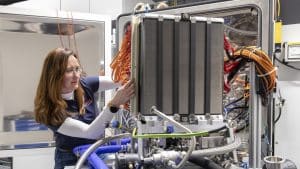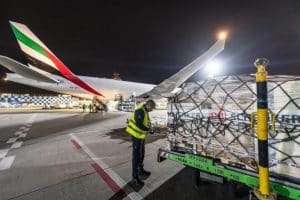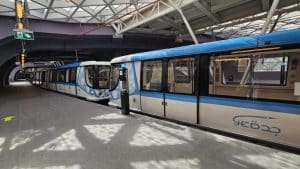
By Phil Le-Brun
Enterprise Strategist at Amazon Web Services (AWS)
During my career in the restaurant business, technology went from being a standalone, assembly-language based point-of-sale system with limited functionality and importance to a highly integrated, mission-critical ecosystem.
Looking back, much of the timing and nature of this evolution was not predictable, but there were certain clear trends that informed pre-emptive bets. These in turn, created agility which is at the very heart of the “digital transformation” debates that rage in companies. Such bets allowed numerous future state options to be pursued, without having to try and divine exactly what the future looked like.

Dominant customer trends today include personalisation, automation, and frictionless experiences, and with good reason. Increasing choice and discerning customers, coupled with restaurant kitchen and menu complexity, drive these demands.
What can we learn from these trends? What are technologies that will allow restaurants to capitalise on these trends, and whatever unexpected trends or needs emerge next? Regardless of how these and other trends evolve, at AWS we see five pivotal technology plays that will give brands the level of agility required to stay ahead.
Data
While journalists proclaim that data is the new oil, business leaders are often left wondering why it isn’t really fuelling their business engine. Whether deriving new operational or customer insights, or implementing new channels, data is more analogous to electricity, connecting every aspect of your business.
A clear bet to place here is in foundational data infrastructure, such as a central data lake for all transaction data and mechanisms for managing master data. It will be an operational nightmare to manage the complexity of automation or voice ordering if master data, such as menu item or site location, is not centrally maintained. The transaction data becomes critically important as well in fuelling ML models that in turn support voice, automation, and sales or product forecasting.
Insights
Most hospitality companies have a good handle on descriptive analytics, understanding what has happened. Nirvana though is to move up the analytics continuum from diagnostic insights, through to predictive insights and, ultimately, prescriptive insights.
The promise of data is not just to be able to find trends that can predict future buying behaviour or stock needs, but also to find questions that you had previously never considered. This starts with the data lake and the democratisation of data. Rather than believing data mining is just the domain of specialists, companies should strive to increase their overall data literacy.
What good is an insight if you cannot use it to change your business? A common phenomenon is the gap between knowing through insights and doing through action. I would prefer to see that insights be called actioned insights. Unless individuals who have the ability to implement changes such as new customer segmentation patterns, anti-fraud measures, menu items, or operational procedures are closely involved in deriving the insights, the value of the insights remains latent.
Automation
Aside from human-actioned insights, the other opportunity is through automation. This starts to get into the realm of ML, IoT, Robotic Process Automation, and equipment automation, all fuelled by data. Successful automation starts with a deep understanding of the business processes and opportunities.
Accountability for these processes needs to extend beyond functional siloes. What’s the point in accelerating order-taking capabilities if your kitchen processes cannot keep up? Once key processes are documented and issues identified, single-threaded leaders can drive action in the areas of the most benefit. These might require automation, but might equally require training, restaurant layout changes, or re-skilling.
Whether IoT and automation take the form of cameras for order accuracy, dynamic pricing on menu boards, proactive maintenance alerts, or full-blown automated cooking, two good pre-emptive bets are ensuring newly installed equipment has an open interface for controlling it, and ensuring applications have APIs to ensure easy access to data.
The cloud
Large franchised brands have an interesting conundrum: balancing standardisation and autonomy. Brands often care about aspects such as consistency of technology to enable rapid deployments. Franchisees have to concern themselves more about investments in hardware and operating costs. These concerns intersect or clash in areas such as reliability and hardware.
Individual franchisees naturally want their technology investments to last while brands like the latest technology in place to support innovative ideas and the latest operating systems. A key trend to help bridge these needs is the cloud.
Under the hood of much of the previous trends is a significant level of technology complexity and compute power that would be difficult to manage in an owned data centre, let alone across hundreds or tens of thousands of restaurants. I see the cloud becoming what economists term a general-purpose technology: a pervasive technology available to all that powers innovation.
Connected technology at the edge
Even with the promises of 5G, restaurants will continue to suffer from connectivity issues. Historically, the architecture workaround for this has been to create systems which could survive a loss in connectivity, but this is now less realistic with new online channels.
That said, there are also an increasing number of technologies where local compute is required. This might be due to legacy applications such as back-office solutions that must run locally, or solutions such as IoT-based automation where super low latency is required.
We already see the growth in solutions like AWS Snowball Edge in factories to enable the centralised management of decentralised compute. Some brands are already moving down a similar path, consolidating in-store compute to extend hardware life and reduce the overhead of deployment and support, while also enabling offline operation where needed.
Similar to the previous trend, to accomplish this means time needs to be invested in ensuring your applications support concepts such as relocatable services (e.g., microservices) and can synchronise services and data between the restaurant and the cloud.
Experience dictates that if the restaurant industry places the right foundational bets, rather than placing big bets just on specific initiatives, our ability to move from traditional laggards to technology leaders grows exponentially. Why bet on voice or chatbots or kiosks or whatever the next hyped trend is when you can position your brand to use any or all of them?












